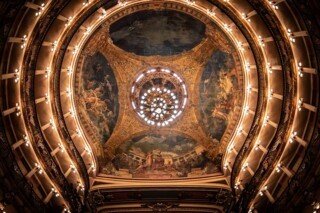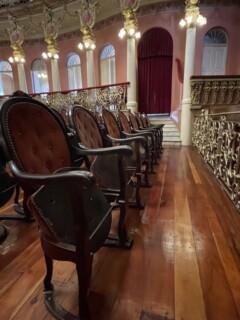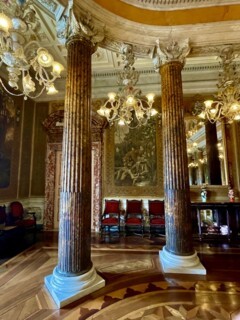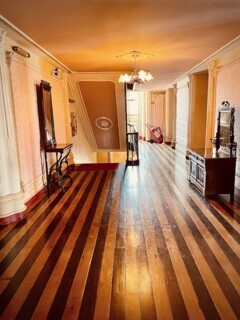At the Teatro Amazonas
Harriet Rix
When Fitzcarraldo in Werner Herzog’s film arrives late for a gala performance at the Teatro Amazonas in Manaus, he has travelled 1200 miles along the Rio Solimões, the main stem of the Amazon, from Iquitos in Peru. His journey would have taken more than two weeks, even before his engine broke and he had to paddle for two days. When I was late for a performance there last month I had travelled six hundred miles along the Rio Negro, which sweeps down from Colombia to meet the Amazon at Manaus, but even by express motorboat, and with only a short stop to fix our own engine breakdown, it took 29 hours; the slow boat upriver had taken five days and nights.
Manaus is a thousand miles from the sea but the river is still wide and deep enough to sustain a port for ocean-going vessels. The meeting of the Rio Solimões and Rio Negro – depicted with swags, flower garlands and the Tupi siren Iara on the theatre’s fire curtain – created a vortex where the trade of the sea met the productivity of the forest, and when rubber boomed, some people became very, very rich.
Between 1880 and 1900, the opera house in Manaus sprouted like a magical pink mushroom out of the rainforest. And, like a mushroom, it sucked out the work of those around it: trafficked Africans, enslaved Indigenous people. The lion’s share of the budget went on exotic touches from Europe: Carrara marble, Murano glass chandeliers and an architect, Celestial Sacardim, from Italy; vibrating acoustic columns of Scottish steel; a dome of green, yellow and blue Alsatian tiles, the colours of the flag of the new republic of Brazil.
I rushed up the curved steps, past the ornamental cycads and through the open doors. There were no tickets – the performance was free – and a young man in a black T-shirt ushered me in. All around me people in their early twenties were wandering in wearing shorts and T-shirts and tight dresses, and around them were the ghosts of thousands of ancient hardwood trees: flip-flops and sandals scraped on floors of pale garapa striped with dark gombeira; in the first-tier gallery, people were chatting on rattan and gombeira chairs against pink satin damask wallpaper.
In the reception rooms on the first floor, putti painted by Domenico de Angelis the Younger look down from the ceiling on a parquet floor of purpleheart, pernambuco and jarana, made by unnamed craftsmen. Beside the Carrara marble pillars there are paintings of jaguars and Brazil nut trees, of the native Acai palm next to the luscious foliage of the Madagascan traveller’s palm, Ravenala madagascariensis, unlikely to survive nine thousand miles from its homeland.
The mahogany doors of the boxes on the grand tier balcony stood open to show glimpses of young people chatting and laughing. I found an empty box and creaked over a floor of jatoba to sit on a red velvet and jacaranda chair. To see the stage, which is made of teak, you clutch one of the famous vibrating columns, and rest your chin on a gallery of red velvet-covered duraka, a tall stiff tree that grows only in one tiny patch of terra firma forest up the river.
A group of young locals came into my box; I tried to leave but they insisted I stay. The house lights dimmed, the audience fell silent and the performance began. The curtain went up, a screen came down and a video of the director of the opera house was projected onto it. He talked about the restoration of the opera house, its role as a meeting place for everyone in Manaus, and he spoke about Covid, which had turned the city into a charnel house, and the joy of being able to meet again in person, in groups.
The screen rolled up to reveal the deep stage and the musicians took their seats. The Amazonas Band was established with state funding in 2000. They played a kind of big band jazz cross-pollinated with a touch of samba and Indigenous dance traditions. The people in the stalls stayed in their seats, but in the boxes, feet tapped and shoulders shrugged. In the gilded box that had been built for Eduardo Ribeiro, the governor of Amazonas in the 1890s, a young woman in a red dress danced with her five-year-old son.
The songs continued: ‘Love Dance’, ‘Paisagem Brasileira’. More friends came to join our party and I left to try an empty box on the other side of the auditorium. A couple of about 14, blushing, came from a dark passageway to join me there. I backed out, also blushing, and tried the empty box right next to the stage. It was dark and dusty, full of wiring, and creepy with the insistent pressure of a thousand dead trees, so I slunk back to my old place, where my new friends were just heading out and invited me to supper, but I chose to stay.
The trumpets blasted and the guitars rolled. Against the great down-sweep of the Amazon and all its culture, the opera house in Manaus stands as an imported rock, a symbol of extractive Brazil. There is still a jagged, painful line between those in Amazonas who extract natural resources and those who try to live within the land’s limits. Upstream, a botanist from the Baré group of Indigenous people had shown me the smoothly barked chevrons on rubber trees, made perhaps thirty years before. She cut a new cicatrice with a machete to show how the latex runs out smoothly and collects into a cup.
Three thousand years ago, rubber was used to make the ball which should not touch the ground, a central game and rite of Mayan cities, and François Fresneau wrote in 1734 about its use as a waterproofing material by the Indigenous people of what is now French Guiana. At first it was one more novelty from the New World for Europeans to play with, but then, like the Mayan ball, it became a central material of the modern city. People all over Amazonas were threatened, bribed and enslaved to collect it. It was vulcanised (mixed with sulphur and smoked over a fire), shipped around the world and blown up into inflatable tyres, revolutionising the wheel.
Manaus was rebuilt; poor people were pushed out of the city centre. But after the rubber came the slump. In the fever of excitement generated by Herzog’s film, restoration work on the Teatro Amazonas was followed by a disastrous reopening in 1990, where protesters shouted: ‘The people paid for this opening, but the people are left outside.’ The opera house was forced to close again within two weeks. Today, Manaus is booming once more – tax-free manufacturing perks have attracted Microsoft, Samsung and Sony – and with that boom comes once again the long arm of property development, removing the floating favelas, replacing the crumbling belle époque houses.
Rubber still blackens the paving stones around the Teatro Amazonas, to muffle the sound of wheels. But it seemed to me that the opera house flourishes on a culture absolutely opposed to Fitzcarraldo’s manic individualism and blind obsession. Free tickets, a young crowd and state funding have absorbed the pink blister into the spontaneous culture of the city. And only a scattering of tourists had travelled more than a thousand miles to get there.




Comments
Terry Wall